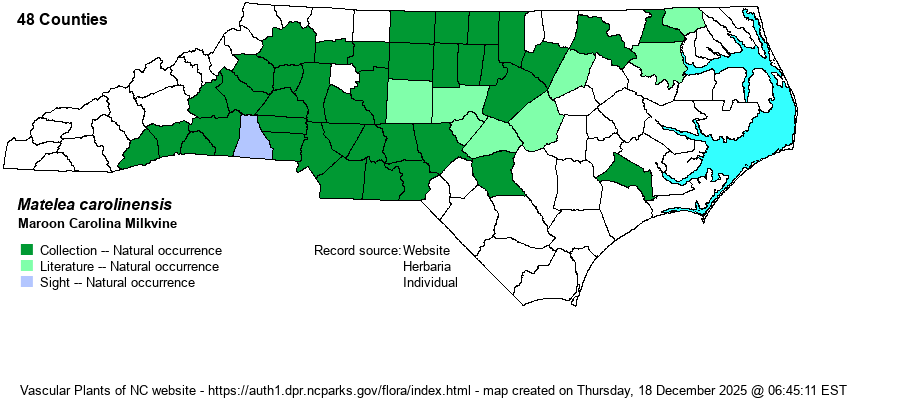| Author | (Jacquin) Woodson | |
| Distribution | [NOTE: The account below is for what is now (summer 2025) known as Matelea carolinensis, without the currently named M. decipiens included within it. A recent paper states that the latter species is restricted to regions west of NC only, leaving the populations in the state "up in the air", most likely just a part of M. carolinensis, but leaving open the possibility of an unnamed species or a distinct taxon within that species.] The current M. carolinensis occurs throughout the Piedmont, and ranges sparingly into the central Coastal Plain. It ranges into the mountains only around Hickorynut Gorge, along the edge of the Blue Ridge Escarpment.
This species is a Southeastern one, ranging north only to DE and KY, and then south to southern GA, southern AL, and eastern TX -- apparently not quite reaching FL. | |
| Abundance | Fairly common across most of the Piedmont, though some populations merge toward M. decipiens or can be intermediate between the two species in some characters. Rare and local in the western and central Coastal Plain, and perhaps absent in the Sandhills region. | |
| Habitat | This is a species of mesic to rich hardwood forests, and their edges. It favors moderate shade, but plants in sunnier and or drier sites look a bit different from those in shadier or moister sites (and thus more toward characters of M. decipiens), prompting the concern that the two species might be just one in NC. It is best seen along margins of hardwood forests. | |
| Phenology | Blooms from April to June, and fruits from July to October. | |
| Identification | This species is an herbaceous vine that climbs over other vegetation to a length of 6 feet or more. It has scattered opposite leaves that are heart-shaped to widely ovate, like many other vine species. The leaves are about 5 inches long and 3-4 inches wide, being pointed at the tip and cordate at the base. The stems and petioles are rather glabrous and seldom hirsute, as in M. decipiens. In leaf axils grow the small flower clusters, usually just 5-8 flowers in a cluster, as opposed to usually 10 or more in the other species. The flowers, a maroon-purple in color, normally are flat (in a single plane), but can show somewhat ascending petals. Each flower is roughly 1-inch across, but the petals are normally only 2-2.5 times longer than wide, as opposed to 4-6 times longer than wide in M. decipiens. All Matelea species have spiny, rough pods and these are not normally useful in separation, as opposed to flower number and shape. Another character used in separation of the two species is that the flowers, when in bud, form a rounded shape, as opposed to a longer and more pointed cone in M. decipiens. The usual habitats of the two typically differ, as M. decipiens is a strong "obligate mafic" species, found only on high pH soils and almost always in dry to xeric conditions, such as glades and barrens, and along margins of dry woods. Unfortunately, plants are seen in mesic habitats that simply are troubling to identify! | |
| Taxonomic Comments | See Distribution. Currently, there are no varieties or subspecies, nor has the species changed names in many decades.
| |
| Other Common Name(s) | Carolina Spinypod, Carolina Anglepod, Climbing Milkweed, Carolina Climbing-milkweed. It is quite obvious that this and other Matelea species have never had consensus common names. However, this website is using "milkvine" as the group common name for Matelea. | |
| State Rank | S4 | |
| Global Rank | G4 | |
| State Status | | |
| US Status | | |
| USACE-agcp | | |
| USACE-emp | | |

